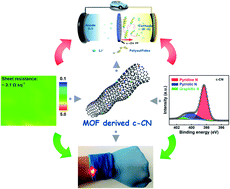MOF-derived conductive carbon nitrides for separator-modified Li–S batteries and flexible supercapacitors†
Abstract
Investigating carbon nitride architectures synergizing high electrical conductivity and enriched nitrogen content have ignited widespread research interest. Herein, layered bamboo-like conductive carbon nitride (c-CN) material is designed and fabricated throughout a metal–organic-framework-derived strategy, targeting emerging energy storage applications in both separator-modified lithium–sulfur (Li–S) batteries and flexible solid-state supercapacitors. When used as a functional separator of Li–S systems, an initial capacity of 1532.1 mA h g−1 could be achieved at 0.2C, with favorable rate capabilities of ∼1145.7 and 996.8 mA h g−1 achieved at 1.0 and 2.0C, respectively. Moreover, the as-prepared c-CN yields a large capacitance value of 333.8 F g−1 with a cycling stability of over 88% capacitance retention after 12 000 cycles when used as the capacitive electrode. The further-derived flexible, symmetric, quasi-solid-state supercapacitor devices exhibit stable performance under deformations, exhibiting extended usability in wearable scenarios. This strategy paves an emerging route toward metal-free materials beyond graphene for use in flexible energy storage devices.

- This article is part of the themed collection: Journal of Materials Chemistry A HOT Papers


 Please wait while we load your content...
Please wait while we load your content...